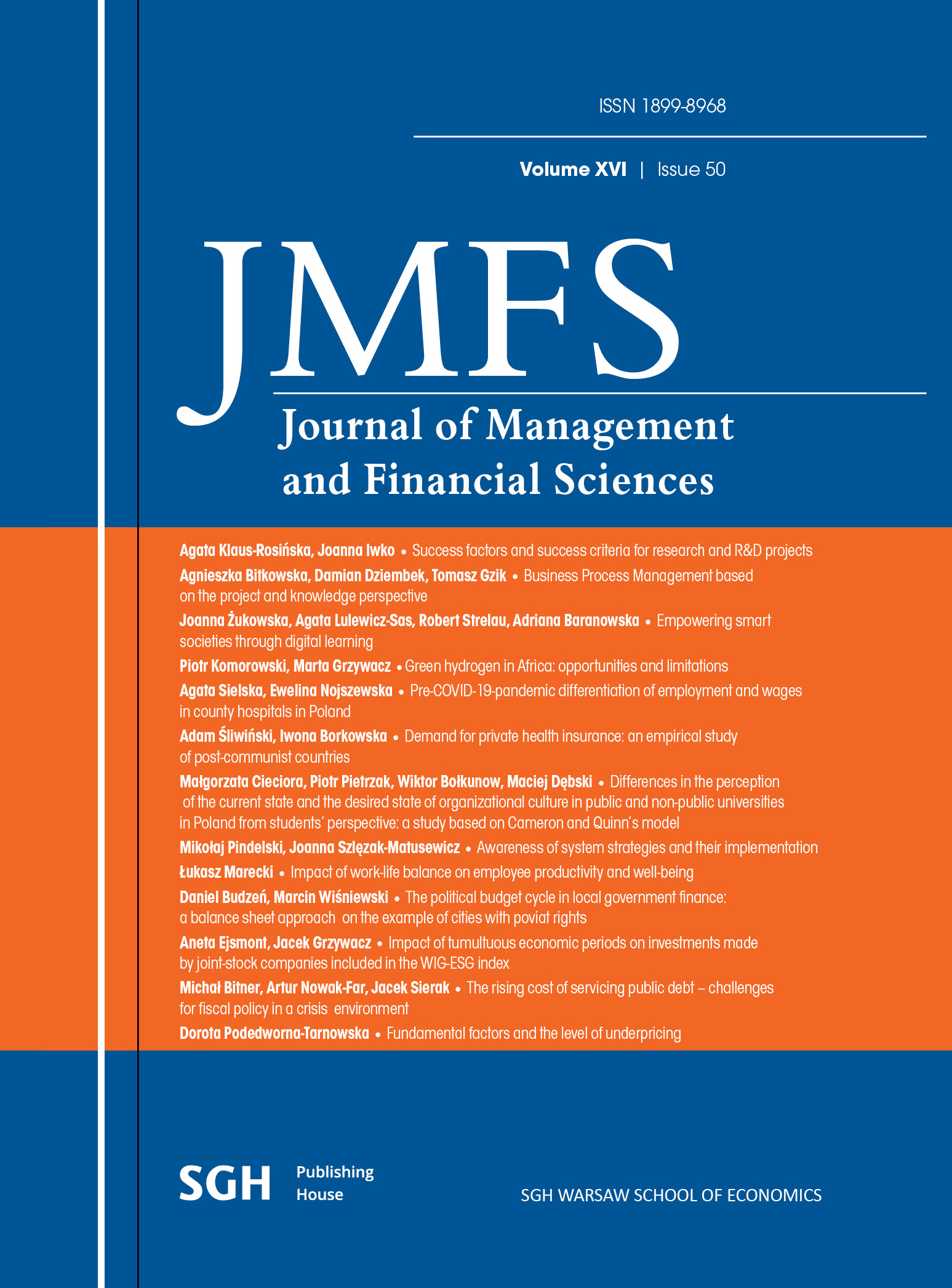Demand for private health insurance: an empirical study of post-communist countries
Main Article Content
Abstract
The development of voluntary health insurance is characteristic of post-Communist and CEE countries. The aim of the paper is to identify the factors determining the demand for private voluntary health insurance. The main finding of the research is that the most important factor is the demographic factor. Other factors include the factor related to the ineffectiveness of treatment under universal health insurance, the factor related to health condition, the demographic factor related to longevity, and the factor related to insurance awareness and income. The research confirms conclusions from previously published studies. The most important is to confirm that the income factor positively influences the studied phenomenon. However, the results shed new light on the aspect of the demand factor, as this indicates the ageing of society and the consequent increase in private spending on health, which are the key mechanisms in the discussion, with the other factors constituting a complementary element.
Downloads
Article Details

This work is licensed under a Creative Commons Attribution 4.0 International License.
References
Aarbu, K. (2010). Demand patterns for treatment insurance in Norway. Department of Economics Discussion Paper, Vol. 11/2010.
Albreht, T., Kuhar, M., Prevolnik Rupel, V. (2022). Complementary Health Insurance in Slovenia. In A. I. Tavares (Ed.). Health Insurance. IntechOpen.
Arrow, K. (1963). Uncertainty and the Welfare Economics of Medical Care. The American Economic Review, 53 (5), pp. 941–973.
Auerbach, D., Ohri, S. (2006). Price and the Demand for Nongroup Health Insurance. INQUIRY: The Journal of Health Care Organization Provision and Financing, pp. 122–134.
Besley, T., Hall, J., Preston, I. (1999). The demand for private health insurance: do waiting lists matter? Journal of Public Economics, 72, pp. 155–181.
Browne, M., Kim, K. (1993). An International Analysis of Life Insurance Demand. The Journal of Risk and Insurance, 60 (4).
Džakula, A. et al. (2014). 2014. Croatia: Health system review. European Observatory on Health Systems and Policies. Copenhagen: World Health Organization.
Emmerson, C., Frayne C., Goodman, A. (2001). Should private medical insurance be subsidised? Health Care UK, pp. 49–65.
Fang, H., Keane, M., Silverman, D. (2008). Sources of Advantageous Selection: Evidence from the Medigap Insurance Market. Journal of Political Economy, 116 (2), pp. 303–350.
Farrington, J., Koylyu, A., Johansen, A. (2019). Better noncommunicable disease outcomes: challenges and opportunities for health systems: Turkmenistan country assessment. Copenhagen: World Health Organization.
Finn, C., Harmon, C. (2006). A dynamic model of demand for private health insurance in Ireland. Discussion Paper, 2472.
Jones, A., Koolman, X., Doorslaer, E. (2006). The Impact of Having Supplementary Private Health Insurance on the Use of Specialists. Annales d’Economie et Statistiques, 83/84, pp. 251–275.
Journal of Laws of 2015, item 1844 with amendments. Ustawa z dnia 11 września 2015 r. o działalności ubezpieczeniowej i reasekuracyjnej, https://isap.sejm.gov.pl [accessed: 10.12.2020].
Journal of Laws of 2020, item. 1398 with amendments. Ustawa z dnia 27 sierpnia 2004 r. o świadczeniach opieki zdrowotnej finansowanych ze środków publicznych, https://isap.sejm.gov.pl [accessed: 10.12.2020].
King, D., Mossialos, E. (2005). The determinants of private medical insurance prevalence in England 1997–2000. Health Services Research, 40 (1), pp. 195–212.
Kutzin, J., Cashin, C., Jakab, M. (2010). Implementing Health Financing Reform. Copenhagen: World Health Organization.
Liu, T., Chen, C. (2002). An analysis of private health insurance purchasing decisions with national health insurance in Taiwan. KSoc Sci Med, 55 (5), pp. 755–774.
Mantis, G., Farmer, R. (1968). Demand for life insurance. Journal of Risk and Insurance, pp. 35–247.
Outreville, J. (1996). Insurance Markets in Developing Countries. The Journal of Risk and Insurance, 63 (2), pp. 263–278.
Outreville, J. (2013). The Relationship Between Insurance and Economic Development: 85 Empirical Papers for a Review of the Literature. Risk Management and Insurance Review, 16 (1), pp. 71–122.
OECD and European Observatory on Health Systems and Policies (2017). The State of Health in the EU profiles Croatia Country Health Profile 2017, http://dx.doi.org/10.1787/888933593418 [accessed: 10.02.2021].
Paccagnella, O., Rebba, V., Weber, G. (2012). Voluntary private health insurance among the over fifties in Europe. Health Econ., 22 (3), pp. 289–315.
Phelps, C. (1973). The Demand for Health Insurance: A Theoretical and Empirical Investigation, Santa Monica: The RAND Corporation Report R-1054‑OEO.
PricewaterhouseCoopers (2023). Rynek ubezpieczeń zdrowotnych w Polsce: szansa na dwucyfrowy wzrost, https://www.pwc.pl/pl/pdf-nf/2023/rynek-ubezpieczen-zdrowotnych-w-polsce.pdf [accessed: 24.01.2024].
Propper, C. (1987). An econometric Estimation of the Demand for Private Health Insurance in the UK. Working Paper, No. 24.
Propper, C., Rees, H., Green, K. (2001). The demand for private medical insurance in the UK: a cohort analysis. The Economic Journal. 111 (471), pp. C180–C200.
Sagan, A., Thomson, S. (2016). Voluntary health insurance in Europe: country experience. Brussels: World Health Organization.
Śliwiński, A., Borkowska, I. (2018). Private Voluntary Health Insurance: Market in Poland and Determinants of Demand – Review of Literature. Economic and Financial Challenges for Balkan and Eastern European Countries, Proceedings of the 10th International Conference on the Economies of the Balkan and Eastern European Countries in the Changing World (EBEEC), pp. 177–192.
Śliwiński, A., Michalski, T., Rószkiewicz, M. (2013). Demand for Life Insurance – An Empirical Analysis in the Case of Poland. The Geneva Papers on Risk and Insurance – Issues and Practice, 38 (1), pp. 62–87.
Thomas, S., Thomson, S., Evetovits, T. (2015). Making sense of complementary health insurance. Copenhagen: The European Observatory on Health Systems and Policies.
van de Ven, W., van Praag, B. (1981). The demand for deductibles in private health insurance. Journal of Econometrics, 17, pp. 229–252.
Vera-Hernandez, A. (1999). Duplicate coverage and demand for health care: the case of Catalonia. Health Economics, 8, pp. 579–598.
Wallis, G. (2004). The demand for private medical insurance. Economic Trends, 606, pp. 46–56.
Zalega, T. (2007). Gospodarstwo domowe jako podmiot konsumpcji. Studia i Materiały, 1, pp. 7–24.
